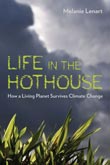“Wetlands are wastelands” was the explanation the chair of a local trust in my city gave for opposing a grant to a wetlands restoration project. He’s a rabid climate change denier and hence unlikely to read Melanie Lenart’s recently published book Life in the Hothouse: How a Living Planet Survives Climate Change. If he did he would discover how wrong he was. Not that he needed wait for her book: it has been evident for many years that wetlands are vital to ecological health. So are forests, which play an equal part in Lenart’s explanation of how Gaia, or, if you don’t like metaphor, the complex interacting system of the biosphere, responds to maintain a temperature within a range suitable for life. A scientist with a background in journalism, Lenart is well placed to provide a coherent account for the general reader of the work of a host of researchers who have explored some of the intricacies of response to warming in Earth’s ecosystems.
She opens with an interesting account of hurricanes as both a symptom of global warming and one of its cures. A warmer world is likely to mean they are more intense. She considers them from the perspective of their cooling function, helping to shift heat away from the tropics. Their destructive power, which is clearly pictured, paradoxically boosts plant life in the sea and on land through sediment stirring and transfer and so aids the drawing down of carbon dioxide from the atmosphere. They also contribute to carbon sinks by burying logs, soil and sediment in landslides, the ocean, and anywhere they can better escape decay. In these respects they are one of Gaia’s natural defences to rising temperatures.
A chapter on circulation patterns explores many of the ways in which precipitation has increased in warmer climates in the past and considers the contribution of such features as the Hadley circulation between the equator and the sub-tropics. The comparative dryness of the ice ages came as a surprise to climatologists. The evidence Lenart adduces spanning the ice ages to ancient hothouses makes it clear that global precipitation rates increased as the climate warmed. This she sees as helping boost a Gaian response to changing climate, namely increased plant growth.
There follows a survey of carbon dioxide uptake by plants and trees and how various forests fared in past climates. More carbon dioxide has meant more growth. More precipitation and more warmth has helped that growth. The contribution of plant life in taking carbon dioxide from the air is significant. The world’s trees alone hold nearly as much carbon as the atmosphere. In this way life becomes part of the Gaian attempt to regulate temperature.
Soils and wetlands also soak up excess carbon dioxide. Wetlands’ special talent for this is related to their remarkable productivity combined with their slow decay rates. Decay stalls in stagnant waters, including the decay of organic material from far and wide that ends up in wetlands because of their low-lying position. The world’s soils are considered by some researchers to hold three times the amount of carbon in the vegetation growing on them. Lenart explains in detail how this happens, with coal being the prime example of the process in the distant past: carbon well sequestered until we started to extract and burn it.
Weathering is the final process Lenart considers as another method by which Earth balances its carbon dioxide ledger. It takes place over a long term and is perhaps not likely to be of much assistance in dealing with our present problems, but it’s a fascinating sequence she describes as nature’s version of acid rain works to break down rocks with a resultant carbon storage in the sea – for limited periods in the case of limestone, but more permanently in the case of basalts and granites, at least until it becomes volcano fodder. Weathering speeds up in hot, humid climates, pulling more carbon dioxide out of the air when there is more than usual there.
I’ve scratched the surface of chapters that are packed with interesting detail about both past and present. Lenart does an excellent job of pulling together information from numerous studies, often updated by direct communication with the experts involved, and building it into a sustained overall picture. The story is enlivened by some of her own direct experience in forest and desert. The good science writer or journalist is able to render the general reader this service in a way that the specialists engrossed in their work would be harder put to provide.
The book’s strands come together in a chapter titled systematic healing. Lenart fully subscribes to the recognition that our use of fossil fuels must be drastically cut. She’s not suggesting any alternative to that. Her particular interest is rather in how we can also work with the natural systems her book has been describing to help moderate the warming and soften the severity of its impacts. She acknowledges that is difficult in our current economy where the bottom line ignores environmental costs and overlooks environmental services. In fact the services provided to humans by wetlands and forests, including urban forests, go well beyond carbon counting. Urban forests provide shade and evaporative cooling valuable in times of elevated heat. She refers to the efforts in Chicago to plant rooftops and increase ground tree and shrub planting as an example other cities might follow. Urban greenery not only cuts heat, but provides habitat for birds and other wildlife, insulates against noise, offers recreational possibilities and reduces air pollution including carbon dioxide. There is even some evidence that it cuts crime!
Forests on a larger scale promote rainfall. Forests and wetlands slow down winds. Wetlands absorb storm surge and slow flooding rivers. They also purify water. Biodiversity and genetic diversity are greatly assisted by wetlands and estuaries. These and many other services are additional to the carbon capture contribution made by forests and wetlands, the protective shield a warming planet produces. Our current experiment is to interfere with the development of these natural protective processes. We are lowering biomass, lowering water tables, lowering the quantities of weathering product reaching the sea through extensive development, logging, groundwater pumping, and river diversion.
Lenart metaphorically shudders at the thought of some of the geo-engineering fixes being proposed. Why build artificial trees to chemically remove carbon dioxide from the atmosphere, she asks, when Gaia can make trees that provide food and shelter, sunscreen and windbreaks, and flood-control and drought-prevention services even while collecting carbon dioxide and other pollutants? She looks to a variety of forest and wetland restoration projects to restore these key systems. The more we can count on forests and wetlands to stabilise the carbon dioxide drawdown, the less pressure we put on oceans to take up the gas and thus increase their acidity. And the more we pull down greenhouse gases into forests, their soils and wetlands, the less need the planet will have for cooling hurricanes and floods. Life gets better at all scales when we boost Gaia’s natural defences.


 Buried among the emails which accumulated while I was in hospital was one from Carbonscape, the NZ company working on biochar, drawing my attention to an article in the UK Sunday Times. It missed proper attention until I tidied up my inbox yesterday, but even a few weeks late I think it’s worth reporting, especially as Hot Topic has posted on Carbonscape previously (
Buried among the emails which accumulated while I was in hospital was one from Carbonscape, the NZ company working on biochar, drawing my attention to an article in the UK Sunday Times. It missed proper attention until I tidied up my inbox yesterday, but even a few weeks late I think it’s worth reporting, especially as Hot Topic has posted on Carbonscape previously ( Government ministers have deliberately played down the role of forestry in meeting emissions targets, documents released under the Official Information Act suggest.
Government ministers have deliberately played down the role of forestry in meeting emissions targets, documents released under the Official Information Act suggest.